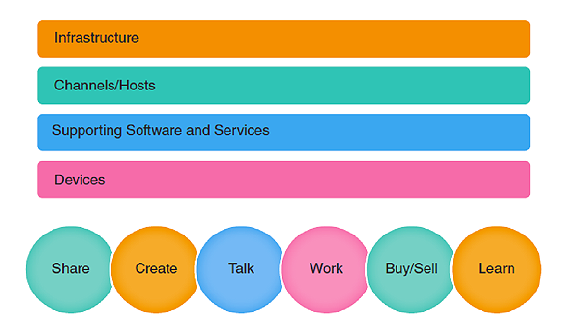Main Content
Lesson 1: Introduction and Foundations
The Infrastructure of Social Media
As a student of social media marketing, recognizing the defining factors of the social media field and how they work together will benefit you as you develop your ability to create marketing strategies and tactics. The social media value chain organizes the complex environment of social media into its core components. The chain illustrates the core activities of social media users and the components that make those interactions possible.

Used with permission of Tuten & Solomon, 2015, Social Media Marketing, p. 17, Thousand Oaks, CA: Cengage.
Infrastructure refers to the basic underlying framework or features of a system or organization. When referencing a country, infrastructure often refers to roads, bridges, railroad tracks, data transmitters, and the people who keep them up and running. The same is true of the World Wide Web and social media. The infrastructure of a social media site includes the following:
- Social software—Behind every social media application is a lot of code that makes it function properly. The underlying software makes it possible for social media to do all of the things that they do. It facilitates interaction between users. It allows users to create content; share content; analyze, search, and sort content; and more. The software includes both the web interfaces (meaning the websites we visit to view pages, like X (formerly Twitter) and Facebook) and the mobile apps or widgets that we use to interact with social media.
- Devices—Of course, we can’t participate in social media without some sort of device. In the early days, this meant our desktop personal computers. Today, we use social media on all manner of devices, including laptops, tablets, smartphones, and more. Devices also include other electronics that produce online content, including webcams, flip cams, and other digital photography and video devices. As the world of social media continues to grow, portability has become a key attribute of social-media-enabled devices.
- People—Of course, all social media software must be written by people (programmers), and all of the devices must be created by people (engineers, designers, laborers, etc.). And going even further, all of the software and all of the devices are completely worthless without people to use them. In the social media landscape, every user is a potential author or contributor.
